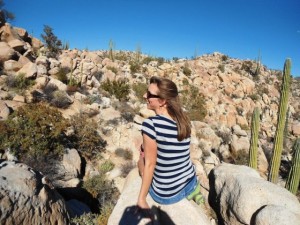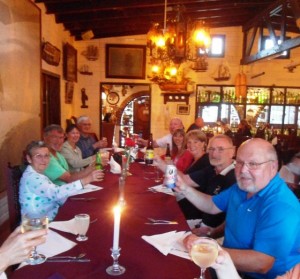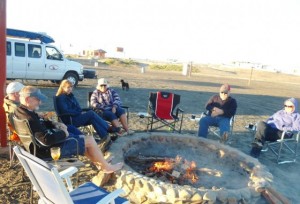
February 11, 2014 – We have arrived in Baja Sur having booked into the Malarrimo Hotel & RV Park yesterday and the sun continues to shine. A look at the long term 10 day forecast show a marvelous weather pattern emerging, warm to hot without much wind, perfect for our beach stays for sure. Dinner last night was very tasty, Lisa and I had the Seafood Platter for two (2), this is the first time we had ordered this, only about $35 Canadian, $32 US, this would be $60-$75 at home if you could find it. This morning the gang is heading out for whale watching and later we head off to San Ignacio and Rice & Beans.

Day 2 saw us leave Villarino’s and head for Fidel’s south of Lazaro Cardenas under blue skies and dry roads. Following our fuel up we headed off to the beach campground, we were the only RVs on site when we drove in. Fidel was happy to see us as usual and had some fire wood for us and our hot dog roast. Fidel says he has secured some funds to complete his restaurant and the government is going to improve his road as it provides the access to the fisherman and local Mexicans alike to this beach. Both will greatly improve Fidel’s business, we wish him all the best of luck pursuing these improvements. Again this season no mud in or out o the campground, we do not miss that mess. We met a young American at Fidel’s, Wayne. He was camping in the dunes and claimed to have been on Baja for 2 ½ years and now heading north and back to the US. We shared some food from the hot dog roast with him, including potato salad and apple pie, not sure when the last time he had a decent meal.

Day 3 and we headed to Catavina. Along the way we came across a red Mazda (Miada?) driving on the front rim, we were puzzled why the driver passed right by a tire repair shop. Later while we were stopped at the Onyx cafe he drove by us and clearly both the driver and car were in great distress. Some locals got him stopped a few hundred feet down the road and we learned the elderly American was lost and very confused. We stopped the caravan at the Police station in Catavina and requested they send along some help, it was good this fella was on Hwy 1, Baja can be a very hard on those without all their facilities. Hard to believe but the Vado on the south end of Catavina as got worse since our last tour, it is horrible. Why they cannot fix this is beyond me, this is Hwy 1 after all. Ralph showed up shortly after we arrived in Catavina and got settled in, he is keeping well. We thanked him very much for the attention and assistance he provided Tom & Linda when their vehicle broke down. We headed out for our Cave Painting excursion and then went to dinner Santa Innes. Later we sat with Bill & Mary from Sechelt and chatted well into the night, Bill had helped me earlier cleaning the burner on the Fridge which had been acting up.

Day 4 now on Mountain Time we were off to Guerrero Negro driving on both the best and worst that Baja has to offer with some of the most stunning scenery. The drive was without incident and problem free. We got a pass at the Military Checkpoint, not uncommon heading south.
After arrival in Guerrero Negro and set up we headed off to Tony’s Tacos, arguably the best on Baja.
Later this evening the gang will have the chance to sample arguably the best Margaritas on Baja!
Did you know? (Part 2)
In Early June, 1847 the two largest ships of the US regional fleet returned to San Francisco to re-supply leaving just the Second Class Sloop Cyane to protect the residents of San Jose del Cabo and La Paz while also enforcing the blockade of Mazatlan. The Cyane was forced to sail back and forth between the mainland and San Jose del Cabo, thus making the blockade of Mazatlan ineffective. There is a great deal of evidence to the contrary, but history is written by the winners. It is more likely that a US incursion prompted Mexican troops to defend themselves.

On July 21, 115 U.S. Army Volunteers landed peacefully in La Paz where the commander of the brigade was very impressed with the prettiest town he had seen in the Californias.
“The houses were all of adobe, plastered white, and thatched with the leaves of the palm tree, and were most delightfully cool. The whole beach was lined with palms, date, fig, tamarind and coconut trees, and their delicious fruit hanging down on them in clusters.”

A private schooner Libertad, chartered from a U.S. citizen living in La Paz harassed trade between Guaymas and Mulegé but was as ineffective in retraining trade there as the fleet had been in Mazatlan. On September 30, the Dale, a third class sloop, ran in to Mulegé under English colors. After it was anchored, it lowered that flag and raised the Stars and Stripes. Lieutenant Tunis Augustus Macdonough Craven, U.S. Navy, tried to go ashore, but was prevented by a party of Mexicans. Local lore says that the Mexicans found every sombrero in town and posted them on sticks behind the fortification making their numbers look larger and thus thwarting the American invasion. Colonel Don Manuel Pineda was in command of the Mexican forces and local conscripts and rejected a call to lay down their arms and proudly stated he would not only repel the invasion of Mulegé, but liberate La Paz as well. On the afternoon of October 1, U.S. troops and the Mulegé forces exchanged fire for several hours without casualties. The U.S. troops were forced to withdraw at sunset. On November 10, the tiny Libertad and the crew of eleven captured the sloop Alerta, about twenty-five miles north of Mulegé.

Meanwhile, resistance to the U.S. occupation grew in Baja Sur, rooted in Todos Santos. San Jose del Cabo declared the occupation at an end on October 23 but changed their minds back when three U.S. warships arrived three days later. A detachment of 31 men was sent to Todos Santos to investigate. While there, the troops were plied with wine and women while word was sent to Pineda to ambush the U.S. troops when they returned to San Jose del Cabo. The ambush never happened and the U.S. forces returned to San Jose on November 7, after a pleasant ‘outing’.

On November 16, 150 Mexicans attacked the 21 U.S. sailors left to defend San Jose del Cabo. In an valiant attack on the positions young Lieutenant José Antonio Mijares was shot and killed. Today he is still revered as a Mexican hero and a statue in his honor can be seen in San Jose del Cabo. The attack on the garrison was abandoned after two U.S. whalers appeared in the harbor, which the Mexican believed to be U.S. warships. Six to twelve of the Mexican attackers were killed and none of the American defenders. At the same time the 115 man U.S. garrison at La Paz was attacked and put under siege. The attack was repulsed under fire from the U.S. 6 pound guns. One American was killed and four or 5 Mexicans. Six days later the troops repulsed in San Jose joined the attack on the La Paz positions bringing the number of Mexicans to an estimated 500. The U.S. garrison was under regular attack until relieved by the Cyane on December 21. During the siege no Americans were killed and a reported 36 graves were discovered left by the attackers. Much of La Paz was burned or plundered by the Mexican troops before their withdrawal.

On January 22, 1848, 8 of Hayward’s men in San Jose were captured by the Mexican insurgents and laid siege to the U.S. positions. By February 11th the Mexicans had recaptured most of San Jose del Cabo except for the U.S. fortifications including the water supply and surrender of the U.S. forces seemed imminent. On February 14 the Cyane reached San Jose and 115 U.S. troops advanced to rescue the garrison. A long fire fight ensued and by the end of the siege three Americans and 13 to 35 Mexicans had been killed. On March 15th, U.S. forces raided Pineda’s camp in San Antonio and freed the 8 soldiers captured earlier in San Jose del Cabo. On March 27 a detachment of 115 men set out for Todos Santos to suppress the insurrection. On the first day Pineda was captured by an advance party and on November 30, U.S. troops captured Todos Santos costing 10 Mexicans and no U.S. casualties. Around the first of April, town leaders of Mira Flores surrendered Mauricio Castro, who assumed leadership of the Mexicans following Pineda’s capture.

By the end of April 1848 all was quiet in Baja.
Continued in the next Blog


